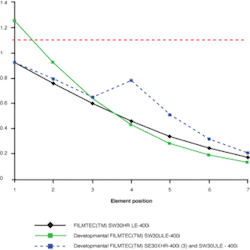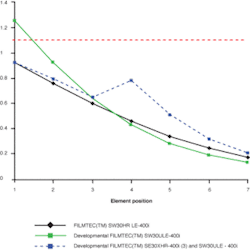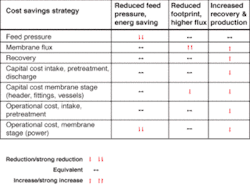Internally staged designs key to Cost Cutting in Desalination
By Markus Busch, Verónica García Molina, Yasushi Maeda, William E. Mickols, Ian Lomax and John Tonner
Not all membrane designs are ideal for seawater desalination, but Dow Water & Process Solutions has developed an approach that can reduce energy costs by up to 7%.
Desalination is essential to providing safe, ample supplies of drinking water to water-stressed coastal areas globally. Advances in pump efficiency, energy recovery devices and higher productivity membranes in desalination facilities have cut the energy costs associated with reverse osmosis (RO), a key function in seawater desalination.
Some sources predict the next substantial energy and cost savings in RO desalination plant operations will derive from membrane technology. Despite an array of products on the market, not all membrane designs are acceptable for seawater RO (SWRO) plants. For water with a fouling tendency, system design and operation will be defined by permeate flux through the membrane, system recovery, individual elements (ratio of permeate flow and feed flow) and the concentration polarization related to flux and recovery. To control fouling, engineering guidelines recommend maximum element production, recovery and/or concentration polarization. These guidelines limit acceptable design configurations and operating conditions.
Conventional plant design limits productivity of new membrane designs due to the high osmotic pressure of seawater feed, which effectively doubles in the brine stream to approach the maximum level of available operating pressure. This high pressure leads to an uneven distribution of flux across the pressure vessel of a seawater plant. Higher temperature, higher TDS feed waters and/or higher productivity membranes may also contribute to uneven flux distribution. One of the negative effects from uneven flux distribution is the potential for higher concentration polarization, which increases membrane fouling.
A novel membrane design concept developed by Dow helps to minimize uneven flux distribution across the pressure vessel using multiple element types in series. The approach was first described in 2004 and is called Internally Staged Design (ISD). The advantages of this approach include:
- Fouling reduction by lower flux on the lead element;
- Higher output per pressure vessel and per element, enabling potential reductions in capital requirements;
- Higher productivity at the same feed pressure and fouling rate for reduced energy consumption; and
- Higher recovery at the same feed pressure/fouling rate, enabling potential economic plant capacity enhancements.
Figure 1, shows three simulations using the same 38,000 ppm feed water to indicate how flux distribution changes when the design is changed from a single element type to ISD.
Operational data of existing and new FilmTec™ elements demonstrate that maximum benefit is attained using high productivity elements with flow rates of up to 11,000 gpd. The number of installed pressure vessels can be reduced by 5-15% using ISD employing high-productivity elements, leading to capital cost savings. Alternately an energy savings of 2-7% is possible when the new designs are used to reduce operating pressure.
Dow determined the most efficient use of the ISD approach is to maintain constant feed pressure and flow, which results in increased recovery and vessel productivity and enables maximum reduction in lifecycle water costs. Energy consumption, pretreatment size, and the number of SWRO pressure-vessels are reduced as well.
Dow’s ISD uses a developmental extra-high salt and boron rejection element (FilmTec SW30XHR-400i) in the first two positions and a developmental high productivity element (FilmTec SW30ULE-400i) in the last five positions. These membranes maintain high rejection of salt and boron throughout the life of the RO module. With lower flow elements in the lead positions, the design distributes flux more evenly, lowering element recovery. The combined effect of lower recovery and flux result in lower concentration polarization and less fouling. ISD design can also:
- Save production costs by decreasing operational pressure;
- Increase vessel productivity at the same recovery rate (higher throughput); and
- Increase recovery up to matching the maximum element productivity recommended for systems using only one element type.
This approach uses various membrane models with different permeate flow rates to produce the highest-quality water while reducing capital and operating expenses. ISD allows designers to balance the flux in the vessel, resulting in a lower fouling risk on the front end elements and high production of rear-end elements. In this model, the high flux and high recovery design also yields considerable savings in the capital/amortization cost of a desalinization plant.
Dow completed a financial analysis using a refined cost model and different economic frame conditions which showed that energy consumption can be reduced by 2-7% when high productivity elements are used. In terms of a reduced capital cost, a 5-12% total reduction due to the reduction in pressure vessels, intake, plant size and pretreatment is possible. The ISD approach has been tested extensively in pilot trials and been installed in a commercial scale plant, yielding recoveries of 50-60% as well as flux rates of 18-25 L/h/m2. ISD and the importance of managing flux have shown to be keys to increasing the economic benefits of desalination operations.
Authors’ Notes: All with Dow Water & Process Solutions, Markus Busch is a global applications specialist, Verónica García Molina is a development engineer, Yasushi Maeda is a senior development engineer, William E. Mickols is a research scientist and Ian Lomax is the desalination global marketing leader. John Tonner is a senior consultant with Water Consultants International. Contact: +1-800-447-4369 or www.dowwatersolutions.com


